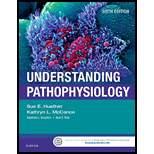Browse All Chapters of This Textbook
Book Details
Master the important pathophysiology concepts you need to know with the most engaging and reader-friendly text available. Filled with vibrant illustrations and complemented by online resources that bring pathophysiology concepts to life, Understanding Pathophysiology, 6th Edition continues its tradition of delivering the most accurate information on treatments, manifestations, and mechanisms of disease across the lifespan, giving you the fundamental knowledge needed to move forward in your nursing education and career. New additions include a new chapter on epigenetics, new content on rare diseases, a separate chapter for male and female reproductive alterations, streamlined features, simplified language, and fully updated information throughout.
Sample Solutions for this Textbook
We offer sample solutions for Understanding Pathophysiology, 6e homework problems. See examples below:
More Editions of This Book
Corresponding editions of this textbook are also available below:
